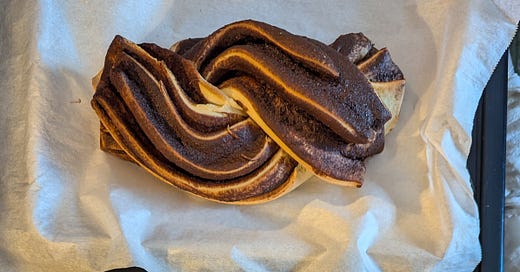Apothecary News: I meant to send out this newsletter last night, but…newborn. So I’m extending the small business sale on the 2025 Lunar + Seasonal Planners to Sunday December 8.
Most of the time, the universe speaks to us very quietly…in pockets of silence, in coincidences, in nature, in forgotten memories, in the shape of clouds, in moments of solitude, in small tugs at our hearts.
~ Yumi Sakugawa
These slow days have asked me to explore how deeply I can nest, how well I can weave these twigs and threads into something supportive, what patterns I can create with them. It’s a fire that burns days and night, bundling up for short walks in the woods, and more than anything; food.
Can a nest be built with flour and butter, scents and sounds? I think they can if they’re incorporated slowly, over the long stretches of snowy days. It might sound impractical to make food that takes hours to tend, but this actually allows for more freedom.
Slow foods aren’t as demanding. They require love in intervals. Most of the time they simply require space and time to simmer, rest, bake, infuse. All the while, they silently solidify the nest with the aroma of herbs and yeast.
Last week I made a quick reference to this Rosół recipe. Many traditional recipes actually call for the broth to be made along with the soup. Folks didn’t go to the store to buy broth, or freeze it in ice cube trays, or even can it. They simply incorporated the making of the broth in with their meal.
I like it better this way. It takes up less room, is freshly infused for a more nourishing and flavorful broth, and offers us the chance to tend the soup more intentionally.
This broth in particular calls for bone-in chicken, carrots, parsnips, celery root, leeks, lovage, and onions. The vegetables are then strained out and the carrots and chicken are added back into the soup along with egg noodles. I don’t think it’s unreasonable now to say that soups tended this way are more warming and soothing than those that take less time. They’ve already fed the family before they’ve finished cooking with their homey scents and simmering sounds.
Another slow food that’s been nourishing me on these cold days is Irish oats. Oatmeal is a food that I fall in and out of love with. I will eat it for weeks on end then not eat it for half a year. Recently though, I discovered steel-cut oats. They have a heartier chewier texture that makes it much more interesting. Because they are a little tougher, they require that longer tending time. You can infuse them overnight or cook them slowly in the morning for about 20 minutes or so.
Also known as porridge, Irish oats are an ancestral food that have been cultivated and cooked simply since around 400 AD. Milk and/or water, oats, and optionally a bit of butter and brown sugar is all that is required.
Lastly, I finally took a day to make my first babka, a yeast cake/bread that originated in the Jewish communities of Poland and Ukraine (and naturally “babka” translates to “grandmother”). It takes hours from flour to finish. It is a reminder that taking the time to make food beautiful holds its own medicine even though it won’t last, or maybe because of it.
The thing all of these recipes have in common is that they are simple. Yes they take time, but that’s about all. Simple clean ingredients like flour, yeast, eggs, roots, herbs, oats give us everything we need. Living in a small town means I don’t have access to more specialty foods and ingredients, so this suits me well.
It may seem impractical to make food that takes such a long time with a newborn, but they actually suit each other quite well. The stretches of time where it is simply resting or cooking allows me to do whatever else it is I need. There’s no mad rush to time everything to be done at the same time or to squish the entire cooking process into a 30 minute window that doesn’t allow the flexibility to care for a baby.
It’s slow, just like the snow, like the shrinking days.
Much love,
Val
P.S. Feel free to share, it’s much appreciated!
If you want to move deeper into a seasonal land-based life, consider ordering my 2025 Lunar + Seasonal Planner. Because learning to live in tune with the land doesn’t come from grand gestures or life-altering shifts, but rather from daily routines, devotions and observations of the land and how we relate to it.
This yearly planner weaves seasonal land-based practices with modern living so that you can live more intentionally and presently within every season of your life. It was created for the plant people, the land lovers, the gardeners, and the seekers to plan their lives around the rhythms of the earth as our ancestors have for thousands of years. More than just a planner, it is a practical yet spiritual guide to living, working, gardening, and celebrating in tune with the ever-shifting world around us.
Become a free subscriber for weekly musings from the forest. To receive seasonal guides and explorations, consider becoming a paid subscriber.








Beautifully said ❤️
As a sourdough bread baker these past 12 years, I agree wholeheartedly, Val! Your babka looks amazing. It's true that the aromas of good, simple foods cooking and baking nourish us before we eat them. I love the way you express these ideas. Hope you and yours are doing well. ❤️